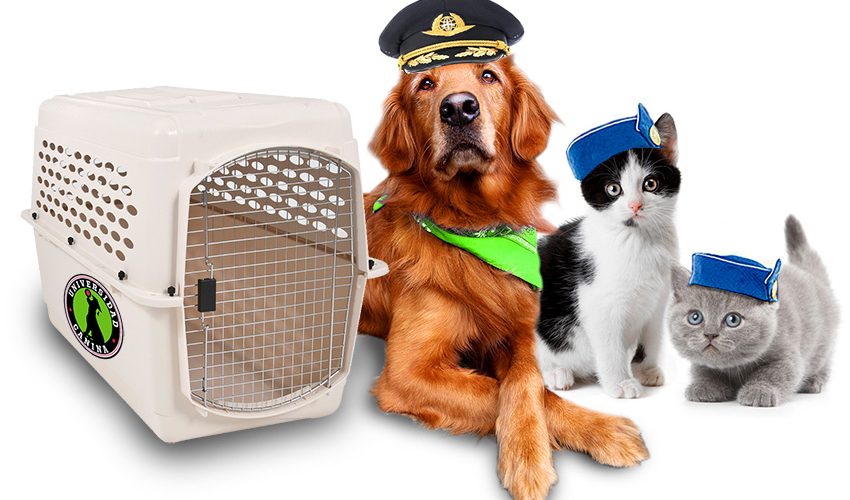
You’re planning a trip and naturally want to bring your furred family member. Before leaving with your cat or dog in tow, know that there are risks to watch for, whether traveling with pets by car or plane. With the proper planning, you can keep your best friend safe during pet travel and collect memories that will last a lifetime.
MOTION SICKNESS
Motion sickness is common in pets,while some pets might vomit once and adjust, others may not. In addition to being an indication of stress and discomfort, it may suggest your pet is not a good candidate for car rides. Vomiting paired with limited access to water on longer car trips can easily lead to dehydration, which is not only unpleasant but can prove to be very dangerous for your pet.
Before taking a chance on a long road trip, try testing shorter rides to see how your companion fares. Also, discuss motion sickness and anti-anxiety medications with your vet. Although you might be tempted to use medications that are made for people, do not give human over-the-counter medications unless previously authorized by your veterinarian—especially Advil and Aleve, or Tylenol to cats, as these can be fatal.
Be sure to discuss anti-nausea and anti-anxiety medications with your vet well in advance of any trip. Often, dose adjustments will need to be made to get the optimum effect for your pet. You’ll also want to be aware of any reactions your pet might have ahead of time.
DRIVING HAZARDS
Some animals react to being on the road by acting out, injuring themselves and creating hazardous driving conditions. If your pet is not confined to a kennel, their activity can interfere with the driver’s ability to control the car and put everyone at risk.
Proper restraint is essential, especially for cats. Except for the most adventurous and chill of adventure cats, all cats should be confined in a cat kennel. They are master bolters and, when fearful, can quickly escape a car or burrow into an inopportune or even dangerous location; for example, beneath a seat or into the driver’s wheel well. Some animals don’t do well in pet carriers, however. Crate confinement in some pets can cause more problems than they help.
In the end, you know your companion better than anyone. How well will they be able to tolerate that environment? Are they used to spending a lot of time in a small kennel? And are there motion sickness or anxiety considerations you will need to take precautions for?
REST STOP DANGERS
Rest stops are a welcome sight when you’ve been driving for a long time, but they also harbor potential risks. Remember, you are likely stopping at the same place many others have stopped for breaks, and anything they might have left behind, your pet may find. This could include a piece of candy, rotten food, trash or even an infectious virus or bacteria that someone’s pet was carrying. Watch where you stop, and find safe places to walk your pet.
Practice good citizenry in return. Pick up all pet waste; there is nothing worse than stepping in dog poop. Plus it is unsanitary, can pollute water for wildlife or our drinking water, and can transmit disease to other dogs or wildlife. Carry dog poop bags with you at all times.
Make sure to keep your pup on a leash. All pets should have a collar with identification as well as microchip with updated information in case they were to escape or get lost. Collars with ID tags can be inadvertently removed if your pet escapes, so a microchip is the safest form of identification.
IN-FLIGHT CABIN RISKS
Some airlines allow a limited number of pets to travel onboard, but it’s not always ideal. Pets that don’t like travel or don’t like their crate may work themselves up to the point that their stress levels can cause significant problems—whether barking, vomiting or relieving themselves in their pet carrier, or even chewing on their kennels to the point they damage the carrier, or worse, break their teeth.
Stressed pets also require more water to support their agitated state, and if they are traveling in a kennel, they might not have access to enough water to keep them well-hydrated.
If you must put your pet in a crate, get your pet acclimated prior to pet travel. Keeping a piece of home in the kennel may soothe your pet; for example, a favorite toy, blanket or one of your shirts. The pet carrier should be an appropriate size for your pet so they can be comfortable and not overly stressed. Anxiety and stress can exacerbate or lead to breathing problems.
You can also try the Platinum Pets Pawsitively Safe dog collar tag or the Pawsitively Safe cat collar tag. Each tag has a unique code that can be entered on their site when a pet is found to reunite pets with owners.
AIRPLANE CARGO HOLD RISKS
Pets weighing more than 20 pounds typically have to ride in the cargo hold. This is hard on any animal, but especially if yours has a low tolerance for temperature extremes. Dogs with short snouts like bulldogs do not tolerate heat, while tall, thin dogs like greyhounds do not tolerate cold.
If you must keep her in the cargo, contact the airline about their pet travel safety record, including where and how dogs will be cared for on layovers, potty breaks and safety; what happens with delays. Your airline should provide guidelines on options for air-travel crates, food and water dishes, and supply of food and water. Cargo travel should be avoided in warmer months.
NOT HAVING THE RIGHT HEALTH CERTIFICATES
Most airlines require a health certificate and proof of rabies vaccination (at the minimum) for domestic travel. If you are traveling with pets internationally, the paperwork can be significantly more challenging, including international health certificates that might be in multiple languages, microchip placement, proof of other medications, inspections by state veterinarians, and diagnostic testing to prove your pet is safe and healthy. Some parts of the world, like Hawaii, will require months of planning, and if the paperwork is not correct, you could be stuck covering the costs of quarantine and additional airfare, among other things.
Educate yourself on the paperwork, your veterinarian can help ensure you have the paperwork you need. Be sure to check in with them weeks, if not months, in advance of your trip if you need documentation to meet any requirements or restrictions at your destination.
The USDA Animal and Plant Health Inspection Service (APHIS) pet travel tool can help you determine the requirements for international travel. These requirements can change from one day to the next, so be sure to check them and also contact your airline to avoid having your animal be quarantined.
DECIDING IF PET TRAVEL IS RIGHT FOR YOUR PET
You know your companion better than anyone. Will they be more stressed out by spending the better portion of the day in a car or kennel and then being far from the familiarities of home, or is she more likely to get more upset by being separated from you while you are away from home?
If you do decide to bring your pet, take some time to plan for the unexpected. Then pack those bags and take your trip with confidence, knowing you’ve done everything to keep them safe.
~At Heart Arrow We Love Pets~

